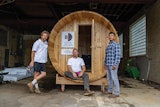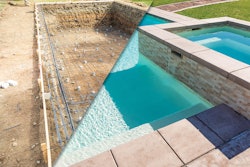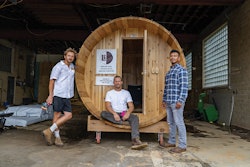
The transition period between when a pool is finished and when it’s handed over to the customer is an important time. To ensure the transition goes as smoothly as possible, builders need to be working toward a successful handoff from the very start of a new project.
Brad Renken, CEO and owner of Hearthstone Luxury Pools + Outdoors in Roswell, Ga., says that when he first got into the pool market, he recognized the pool handoff was something that was in need of attention.
“It wasn’t common for builders to do much for their clients in the past. It was, ‘Here are the keys and here you go.’ Certainly as our market has changed, especially influenced by HGTV even, people are expecting a higher response from their builders,” Renken says.
Builders have been doing more and learning better ways to streamline the transition process. Here are tips on how to go about the handoff the right way to put customers at ease after their large investment.
SETTING EXPECTATIONS
In today’s digital age, customers come to a consultation having done a fair amount of research and with high expectations. They have searched through a number of forums (some with angry customers) and have a list of questions, design ideas and worries. As a builder, it’s important to set boundaries and expectations early to ensure a successful result and to ward off future problems.
“People will go on Pinterest and on forums all the time. They will try and tell you how to build their pool,” says Nathan Caldwell, construction superintendent and construction warranty administrator at Gohlke Pools in Denton, Texas. “It’s your job to hit the breaks and say, ‘This is the way that we are going to build it [with respect to your budget].’”
Part of the startup process, then, inevitably involves un-educating your customer. “I spend a lot of time un-educating or re-educating some myths that customers have picked up on from the internet,” says Renken.
“The sooner you educate them on exactly what is going to happen, the turnover of that pool is going to go a lot smoother.”
RELATED: Teaching Water Chemistry to Homeowners
The key is to be patient and go at the customer’s pace. A pool instruction packet, complete with a construction schedule, is a great way for customers to feel involved from start to finish. And it’s something customers can refer to during “pool school” after the build is complete.
SCHOOL’S IN SESSION
The idea of caring for a pool and all that comes with it is a daunting task for new pool owners. Not to mention the words “water chemistry” usually leave customers shaking their heads. That’s where “pool school” comes in.
Pool school is a great opportunity for builders to walk customers through the ins and outs of their pool. “We spend 1-2 weeks getting the water chemistry straight after the build is complete and once we get everything balanced, then we schedule a pool school,” says Caldwell.
Renken has a similar process. “We use the pool school as an opportunity for customers to ask questions,” he says. “We give them a nice packet of information about how to run a pool and phone numbers and resources they can contact with any concerns.”
The pool school can also address any safety concerns — which, for customers with little ones, can put parents at ease. “We include all of the safety brochures and a video,” says Caldwell.
This is also an opportunity to sell additional add-ons. “We talk about what we can do to help keep an eye on the kids,” says Caldwell. That might include a double-sided deadbolt with keys on both sides of the back door, a safety cover, a safety fence or an alarm — all things that can increase customer satisfaction and your bottom line.
SERVICE TEAM
Whether you have a service company vetted for clients or a service team of your own, it’s important for customers to have an abundance of help in the first month (minimum) after the build is complete. “It’s very difficult for a customer, certainly someone who doesn’t know what they’re doing, throughout that first month,” says Renken.
Renken chooses not to employ a service company of his own, so he’s built a great relationship with two companies in his area — Absolute Pool & Spa Care and Pool Tech — to give his clients the service support they need. He even funds the first month of service for the customer. “Having a good, vetted service company that can take care of your customers makes the customer feel good and makes the builder look good,” he says.
For Caldwell, the build-to-service transition simply consists of him introducing the customer to Gohlke Pools’ own service segment. He also gives customers one free month of service after each project but, if the customer is struggling or is extra nervous, he will extend the complimentary service to three or even six months.
Free service also helps business. “If the service department can get in the backyard and take care of the pool before the homeowner does, the homeowner is probably never going to take care of the pool themselves,” says Caldwell. “75% to 80% of customers with a new pool build sign on to receive service.”
THE DIY CUSTOMER
Some customers will inevitably choose to service the pool themselves, but that doesn’t mean sales opportunities have to end. For builders with retail branches, this is an opportunity to bring in future business.
RELATED: Eric Herman Commentary: The DIY Conundrum
“Before the handoff, we will introduce DIY customers to our retail store,” says Caldwell. “With an introduction, they feel more comfortable coming into the store for water testing and chemicals down the road.”
Caldwell still offers DIY customers a free month of service after the pool build is complete because he likes to leave customers confident in measuring chlorine, pH, total alkalinity and cyanuric acid. He encourages customers to measure other elements at the water testing station each month.
HOLD BACK ONE PAYMENT
Another tactic some builders use is to keep the financial account open until after the handover, thereby communicating the idea to the customer that the builder is still onboard. While holding back a final payment might make some builders nervous, Renken believes it gives customers an extra sense of the builder’s commitment.
“We keep one final payment, just $1,000, back until the month [of free service] is over,” he says.
This can also give you the opportunity to iron out any concerns the customer might have before you completely close the project. They won’t want to pay that final bill until they’re satisfied and comfortable, which can only help you end with a positive review.
FOLLOW-UP
Finally, when the build is complete and the customer is left with their beautiful, new backyard addition, it’s important to reach out to them to follow-up. “The big thing we can do is let them know we’re here, we’re not going anywhere and you have a lifetime membership to free pool schools forever,” says Caldwell.
Caldwell has had customers reach out to him as far as six months after the completed build, with some following-up as much as four times. It’s all worth it. “I love to check in on them because it lets them know you’re still there, that they are still in your peripherals and you’re still thinking about them.
“It really comes down to: Were they comfortable with you throughout the process? Were they confident in letting you walk away from the project?” says Caldwell. “Those people will tend to call everybody they know and tell them how great you are.”












































